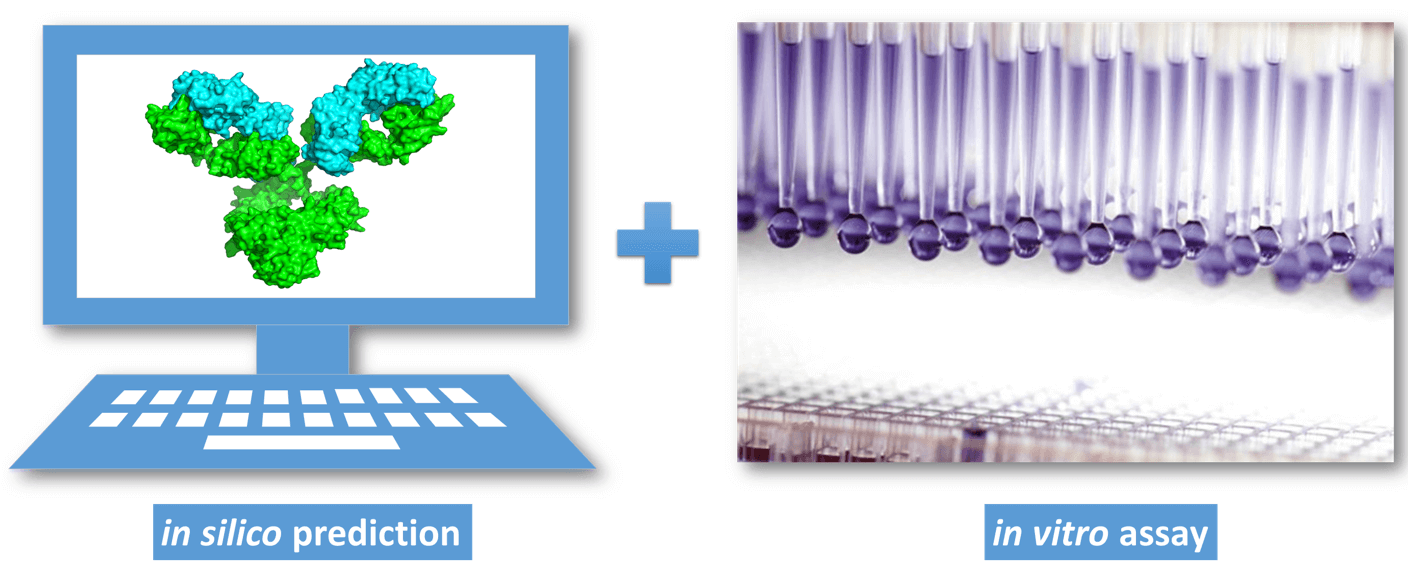To help screen out top molecules from dozens of candidates, Creative Biolabs has developed an advanced assay module for preliminary screening, by which in silico and in vitro assays are combined to evaluate and rank a large number of candidates in a high-throughput manner. Top candidates will be selected and subjected to further comprehensive assessment in the later stage. Potential PTM sites in the complementarity determining regions (for antibody drugs) and the theoretical isoelectric point (pI) are determined in silico based on the amino acid sequences. Expressability, aggregation, physical stability, and other properties are assessed in vitro.
 Fig.1 High-throughput preliminary screening module of the CreDA™ platform.
Fig.1 High-throughput preliminary screening module of the CreDA™ platform.
In Silico Assessment
Post-translational modifications (PTMs)
Undesirable PTMs may affect product stability, increase the difficulty of formulation development, reduce the biological potency, and even increase the risk of immunogenicity. Amino acid sequences of the candidates are first scanned in silico for potential PTM sites in the CDR regions. Asparagine deamidation, aspartate isomerization, methionine or tryptophan oxidation, free cysteine residues, potential glycosylation sites, and other possible PTMs are all marked and evaluated for their effect on candidate selection. For example, the presence of deamidation site in the CDR, which may sharply reduce the biological potency, will result in de-selection of the candidate. Other less critical modifications are assessed along with the in vitro data of each candidate.
Isoelectric point
It is of great importance to select candidates with appropriate charge properties that fulfill requirements of purification process in an established downstream platform. Isoelectric point (pI) is a predictor in this respect and is determined in silico based on the amino acid sequence.
In Vitro Assessment
Expression
Candidates of poor expression will result in inadequate protein material for in vitro assays in the preliminary selection phase. Expression titer of the candidates is therefore determined by transient expression in human embryonic kidney cells (HEK293) or other appropriate systems. The protein content is determined using a high-performance liquid chromatography (HPLC) system equipped with an analytical protein A column (for antibodies). Low expression titer will result in de-select of the corresponding candidate. The identity and integrity of each purified candidate is also checked by mass spectrometry analysis.
Aggregation
Protein aggregation can occur during expression, purification, formulation, and use of the drugs, which may lead to increased variability among batches in manufacturing, lower efficacy, and even in vivo immunogenicity. Therefore, aggregation propensity is a critical quality attribute that is determined and used to eliminate candidates in the preliminary selection process, as well as in the comprehensive assessment phase. The extent of protein aggregates is analyzed by size exclusion chromatography or multiangle light scattering.
Physical stability
Physical stability is assessed by differential scanning fluorimetry using the thermofluor assay. Rising temperature will eventually cause the globular protein to unfold or melt. And the determination of the melting point (Tm) provides a measure of the stability, with more stable candidates requiring higher temperatures to unfold.
Hydrophobicity
Candidates with higher hydrophobicity tend to show an increased propensity of aggregation. For this reason, hydrophobicity is assessed in the preliminary selection stage. Surface hydrophobicity is experimentally measured by determination of the ammonium sulfate concentration at which the candidates will elute from a hydrophobic interaction chromatography (HIC) column.
Evaluation of the assay results
In this preliminary screening campaign, express ability and aggregation propensity are two critical risk factors, which directly result in candidate de-selection if these properties are undesirable. Other attributes, such as pI, physical stability, and hydrophobicity, are thought as cumulative risk factors, which may affect candidate ranking in combination. Based on the assay results, the risk level of each candidate is labeled as low, medium, or high. Candidates of high-risk are directly de-selected, and the remaining candidates are ranked, taking technical developability, sequence diversity, as well as biological activity into consideration. Top candidates are finally selected and characterized in more details during the comprehensive assessment stage.
With years of experience in drug research, Creative Biolabs has gained significant knowledge in the developability assessment of biopharmaceutical candidates. We are more than happy to share our experience and help our customers select the most promising candidate for process development. Please contact us for more information and a detailed quote.
For Research Use Only.

 Fig.1 High-throughput preliminary screening module of the CreDA™ platform.
Fig.1 High-throughput preliminary screening module of the CreDA™ platform.